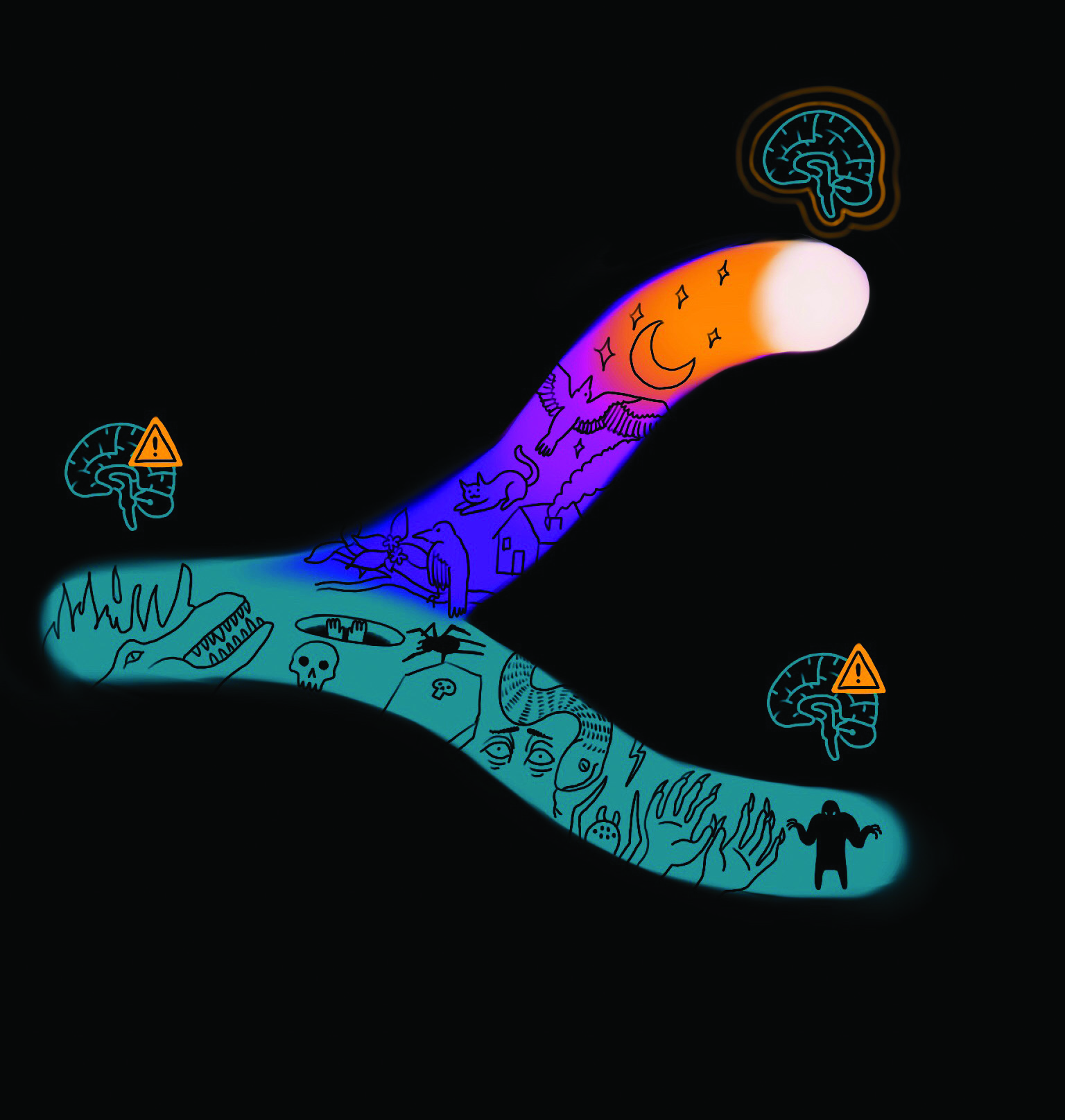Why Do We Dream?
Dreams have held cultural and religious significance throughout history, and in some cases, they have influenced history or culture themselves. James Watson, who won the Nobel Prize for discovering the structure of DNA, claims that his breakthrough came to him in a dream, which shaped biological science into what it is today. [1] The horror novelist Stephen King cites his graphic dreams as inspirations for his novels, which have sold hundreds of millions of copies worldwide. [1] While Watson, King, and many others point to dreams as their eureka moments, most dreams don’t offer such clarity. After all, the majority of dreams are illogical, emotional narratives with intense visual imagery. [2] In other words, they often make little to no sense, so why do we dream at all? Neuroscientific and psychological research suggests that dreams may help maintain our mental and emotional well-being by regulating our emotions and consolidating our memories during sleep.

Dreams and REM Sleep
While dreams have long been a topic of intrigue in psychology, they weren’t studied as neurological phenomena until the discovery of rapid eye movement (REM) sleep and non-rapid eye movement (NREM) sleep in the 1950s. [3] Researchers used electroencephalograms (EEGs) to measure electrical activity in the brain during sleep and discovered that while NREM was a relaxed state with low mental activity, REM had high levels of mental activity that resembled waking states. [3] This discovery led researchers to suspect that REM’s brain activity may lead to dream production. [4]
One of the earliest studies that directly observed the connection between REM and dreaming came from Eugene Aserinsky and Nathaniel Kleitman of the University of Chicago. They placed electrodes above and below study participants’ eyes to measure eye movement during sleep, which allowed them to determine when the participants were in NREM or REM. [5] Aserinsky and Kleitman then woke up the participants at various stages of NREM or REM and asked them to recall any dreams they had immediately before awakening. Of the participants woken up during NREM, only 9% could recall their most recent dream. Meanwhile, 74% of participants woken up during REM were able to describe their most recent dream in vivid detail. Aserinsky and Kleitman subsequently hypothesized that the higher level of neural activity during REM produced more dreams compared to NREM, in turn influencing dream recall. [5] Current research, however, has now established that REM is not wholly responsible for dream production; dreams can occur during both sleep onset and NREM, and REM can occur without dreams. [4] Dream research continues to focus primarily on REM dreams because of the strong correlation between REM and dream recall. [4]
A particularly useful method for studying brain activity during sleep is a positron emission tomography (PET) scan. PET scans involve the injection of a radioactively-labeled molecule into the bloodstream, which is detected via imaging. Higher concentrations of the radioactively-labeled molecule in certain regions of the brain are associated with higher levels of activity in those regions. Studies using PET scans to analyze REM brain activity have found that the motor cortex, visual cortex, hippocampus, and amygdala, among many other brain structures, are active during REM; however, they do not activate REM sleep themselves. [6, 7, 8] The activation of these brain structures potentially corresponds to different features of dreams. For instance, the visual cortex and motor cortex may contribute to visual and motor hallucinations, while the hippocampus, normally involved in memory processing, may insert familiar scenes into dreams. [2] Additionally, the amygdala may be responsible for the emotional nature of dreams, stemming from its normal function in emotional regulation. [2] The inactivation of certain brain structures can be telling as well; for instance, a major region of inactivity during REM is the dorsolateral prefrontal cortex (DLPFC). [6] As the DLPFC is a center of cognitive control and reasoning, its inactivation is often associated with the bizarre narratives of dreams as well as the inability to distinguish dreams from reality. [2] Understanding brain activity during sleep and how it may affect the nature of dreams provides major insight into the possible functions of dreaming. In particular, the activation of the amygdala and the hippocampus during REM inspired two major dream theories: the emotional regulation theory and the memory consolidation theory.
Emotional Regulation Theory

It seems logical that dreams are reflections of an individual’s mental and emotional state. For instance, studies have shown that individuals with major depressive disorder have more negative dreams than mentally healthy individuals. [9] Later research has suggested that dreams may even actively regulate an individual’s emotional state. Rosalind Cartwright, Professor Emeritus at Rush University Medical Center, designed a study to test if negative dreams were correlated with mood regulation in people with no prior history of depressive episodes. [9] Cartwright and her team assessed the study participants’ emotional states prior to sleep and then woke them up after each stage of REM. Upon waking, the study participants had to recall their most recent dream and evaluate their dream as positive, negative, or neutral. Cartwright found that the individuals with no depressed mood prior to sleep had the same number of positive and negative dreams throughout the night, while individuals with a mild depressed mood prior to sleep had more negative dreams at the beginning of the night but significantly fewer later in the night. [9] In a separate study, Cartwright discovered that depressed individuals who had decreasing negative dreams throughout the night were more likely to be in remission from situational depression after one year than individuals with increasing levels of negative dreams. [10] Based on her results, she hypothesized that the earliest negative dreams are the brain’s attempt to regulate mood during sleep, while the later negative dreams indicate the brain’s failures in mood regulation. [10] This causal relationship, however, has yet to be established.
Another study analyzed whether the amount of REM sleep could predict an individual’s response to fear conditioning. [11] Study participants used sleep monitoring devices for a week to determine their average length of REM sleep per night. The participants then underwent fear conditioning, in which they learned to associate different colors of light with electrical shocks. During the conditioning, the researchers took scans of the participants’ brains, focusing specifically on the activity within the amygdala, which is heavily involved in the fear response. The researchers found that more time in REM sleep prior to conditioning was associated with decreased amygdala activity, implying a reduced fear response. [11] REM dreams may similarly be negatively correlated with fear. However, whether dreams truly cause reduced fear or modulate negative mood is still unknown.
Memory Consolidation Theory
Perhaps the most popular theory of dreaming is that dreams attempt to make sense of an individual’s recent experiences. Dream reports provide strong evidence for the memory consolidation theory, as many of them link elements in dreams to elements from an individual’s waking life. [4] Dreams are rarely replays of memories of life events; rather, they draw upon different isolated aspects of waking events. [4] In addition, dream reports have established that dreams frequently incorporate memories from the day before and from the week before. [12] Compared to the day-old memories, the week-old memories are more focused on relationships, locations, and positive emotions, suggesting that the incorporation of specific memories is time-dependent. [12] Interestingly, similar sets of neural processes across individuals, such as those during REM, can generate highly subjective dreams that largely draw upon memory for their content.

Studies utilizing PET scans also support REM’s role in memory consolidation. In one study, researchers took PET scans of participants’ brains while they completed a reaction time test and again while they slept. [7] A control group, which did not complete the reaction time test, only had PET scans while they were asleep. The researchers found that the brain regions active during the reaction test were significantly more active during REM in the experimental group compared to the control group, supporting the role of REM in memory processing. [7]
On the other hand, brain lesion studies and drug studies have been inconclusive about whether REM is involved in memory at all. For instance, a lesion in a certain region of the brain results in the complete loss of REM sleep; however, studies have shown that individuals with this type of lesion do not show cognitive or memory deficits. [13] Some antidepressants can cause a similar, yet temporary, effect of REM sleep suppression, but they also do not negatively impact memory. [13] Together, the lesion and drug studies suggest that REM is not essential for memory. It is still possible that dreaming is correlated with effective memory consolidation, as supported by results from dream reports and PET scans, but whether dreaming causes memory consolidation or vice versa is still undetermined. Further neuroscientific research is needed to more firmly establish the relationship between dreams and memories.
Dream On
The neuroscientific approach to dream research has yielded fascinating insights into the mechanisms of dream production and alluded to the potential functions of dreams. Dreams may play a role in actively regulating emotion, particularly in cases of low mood and fear, and may also be involved in memory consolidation. While there is currently no strong consensus on what dreams do for us, continued research can clarify how dreams factor into our mental and emotional well-being. If dreams can be manipulated, then research can determine causal relationships between dreaming and various cognitive functions. A better understanding of dream mechanisms may even lead to treatment interventions for certain mental illnesses, such as suppressing schizophrenic hallucinations or nightmares from PTSD. [14, 15] Until then, however, uncovering the true purpose of dreaming is simply a dream itself.
References
- Emekwulu, P. C. (2010). Mathematical Encounters: For the inquisitive mind . Xlibris Corporation.
- Ruby, P. M. (2011). Experimental Research on Dreaming: State of the Art and Neuropsychoanalytic Perspectives. Frontiers in Psychology,2 . doi:10.3389/fpsyg.2011.00286
- Dement, W., & Kleitman, N. (1957). Cyclic variations in EEG during sleep and their relation to eye movements, body motility, and dreaming. Electroencephalography and Clinical Neurophysiology, 9 (4), 673-690. doi:10.1016/0013-4694(57)90088-3
- Stickgold, R. (2001). Sleep, Learning, and Dreams: Off-line Memory Reprocessing. Science, 294 (5544), 1052-1057. doi:10.1126/science.1063530
- Aserinsky, E., & Kleitman, N. (1953). Regularly Occurring Periods of Eye Motility, and Concomitant Phenomena, During Sleep. Science, 118 (3062), 273-274.
- Maquet, P., Péters, J., Aerts, J., Delfiore, G., Degueldre, C., Luxen, A., & Franck, G. (1996). Functional neuroanatomy of human rapid-eye-movement sleep and dreaming. Nature,383 (6596), 163-166. doi:10.1038/383163a0
- Maquet, P., Laureys, S., Peigneux, P., Fuchs, S., Petiau, C., Phillips, C., . . . Cleeremans, A. (2000). Experience-dependent changes in cerebral activation during human REM sleep. Nature Neuroscience, 3 (8), 831-836. doi:10.1038/77744
- Braun, A. R. (1998). Dissociated Pattern of Activity in Visual Cortices and Their Projections During Human Rapid Eye Movement Sleep. Science,279 (5347), 91-95. doi:10.1126/science.279.5347.91
- Cartwright, R., Luten, A., Young, M., Mercer, P., & Bears, M. (1998). Role of REM sleep and dream affect in overnight mood regulation: A study of normal volunteers. Psychiatry Research,81 (1), 1-8. doi:10.1016/s0165-1781(98)00089-4
- Cartwright, R., Young, M. A., Mercer, P., & Bears, M. (1998). Role of REM sleep and dream variables in the prediction of remission from depression. Psychiatry Research,80 (3), 249-255. doi:10.1016/s0165-1781(98)00071-7
- Lerner, I., Lupkin, S. M., Sinha, N., Tsai, A., & Gluck, M. A. (2017). Baseline Levels of Rapid Eye Movement Sleep May Protect Against Excessive Activity in Fear-Related Neural Circuitry. The Journal of Neuroscience,37 (46), 11233-11244. doi:10.1523/jneurosci.0578-17.2017
- Nielsen, T. A., Kuiken, D., Alain, G., Stenstrom, P., & Powell, R. A. (2004). Immediate and delayed incorporations of events into dreams: Further replication and implications for dream function. Journal of Sleep Research,13 (4), 327-336. doi:10.1111/j.1365-2869.2004.00421.x
- Siegel, J. M. (2001). The REM Sleep-Memory Consolidation Hypothesis. Science,294 (5544), 1058-1063. doi:10.1126/science.1063049
- Waters, F., Blom, J. D., Dang-Vu, T. T., Cheyne, A. J., Alderson-Day, B., Woodruff, P., & Collerton, D. (2016). What Is the Link Between Hallucinations, Dreams, and Hypnagogic–Hypnopompic Experiences? Schizophrenia Bulletin,42 (5), 1098-1109. doi:10.1093/schbul/sbw076
- Hopwood, M. (2014). Features of Posttraumatic Dreams Related to PTSD Severity. Journal of Traumatic Stress Disorders & Treatment,03 (03). doi:10.4172/2324-8947.1000127
